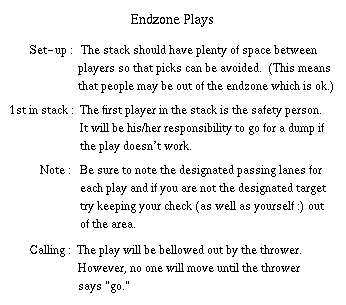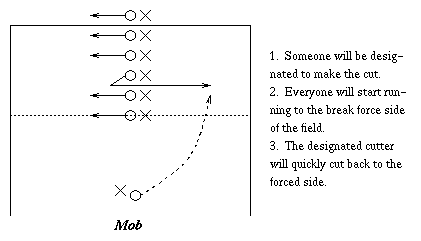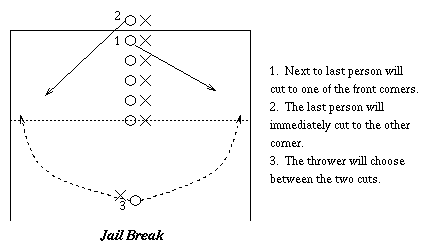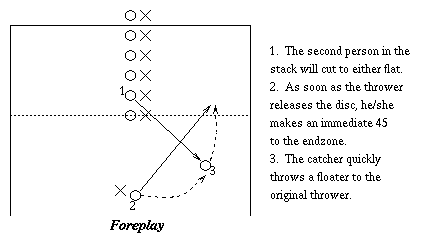|
|
|
This guide was first put together in 1996 to help describe what we wanted to have happen on the field without having practices. The most advanced players on the team had just three years playing experience. In the end, things worked out quite well.

Playing person-to-person defense starts with a good force and everyone
denying the person that they are covering to get open on the forced
side of the field. The following figure explains.
Often times when playing person-to-person defense, the disc will begin
on the sideline or work its way there. A team may take advantage of
this by forcing the disc up the sideline and allowing one person to play in the
narrow passing lane. This set up is called a sideline trap and is shown
below. When a defender sits in the passing lane guarding
no specific player while the other defenders still play person-to-person,
this defender is said to be poaching.
When playing person-to-person defense, the defender must always react to the
offensive player. If everyone is able to keep up with his/her check, this
works well. However, playing a zone defense forces the offense to react to
the specific defensive set up. Here is a listing of several different
zone defenses.
Perhaps the most important thing with a zone defense is good communication.
Each line of the zone defense will talk to the previous line letting them
know who is behind them. (e.g. The deep(s) will talk to the middles.)
The players who are not playing can also help a great deal with communication.
(Note: the left middle and right middle are also called the
left hammer or left hammer stopper and the right hammer
or right hammer stopper.)
Note: strong-side = same side of the field the disc is on. weak-side =
opposite side of the field that the disc is on.
The cup will always chase the
disc. Only one of the sides of the cup will mark the disc and call out
the stall count. (Nobody else may do this.) The other people in
the cup play exactly ten feet
off the disc unless there is an offensive player within ten feet in
which case the defender may follow him/her in. When the disc is swung,
the cup tries to contain passes from getting up the field before
tightening up again. The middles look to cover
offensive players in their zone paying special attention to the
passing lanes through the cup. The deep watches people behind the
middles.
The zone described here is called a 3-3-1 zone because there's
3 people in the cup, then 3 people in the middle, and finally
1 person deep. Another standard zone is a 3-2-2. I'll let you
figure out that one.
Note:
Communication is very important. The top of the cup talks and
directs the other people in the cup. The middle-middle directs
the top of the cup. The deep directs the middles. The players
sitting off help the hammers and warn the deep when someone is
behind him/her.
This zone is particularly devastating when the trap is set up
as shown in the figure on the right. Thus, one of the goals of this
zone is to force the disc to the sideline without giving up to much
ground. If there's any kind of cross wind, then the fish should
force the disc towards the sideline that is in the downwind direction.
This makes getting the disc out of the trap situation even harder.
Note: strong-side = same side of the field that the disc is on.
weak-side = opposite-side of the field that the disc is on.
After playing this zone almost exclusively now with my league
team La Guarapachanga in the summer of 1997,
we've come up with a slight
variation. The idea is the same -- force the other team into a trap
situation, but the set-up is slightly altered as shown in the figure
below.
This is still in its experimental stage, but I have played on teams
where we have done a wall 1-4-2 set all the way down the field with
much success.
This is only used for fun and on
very windy days. One person will mark the disc and one
person will play back. Everyone else forms a line across the
field. When the disc is moved, the player closest to the disc
will go to mark it and force it back towards the middle
(and a little foward). The
player that was marking the disc will go back into the wall.
Everyone else will adjust to make room for the old marker and
take up the void left by the new marker.
The standard zone uses a 3 person cup. A competent group
of handlers can usually move the 3 person cup around a lot.
In order to give a different look and make the handler passes
more difficult a 4 person cup can be used.
The cup plays
fairly loose. The top of the cup almost plays even with the disc,
sometimes even cheats towards the sideline. This makes for a very
small opening through the cup towards the sideline and for the middle
on that side to ignore it and instead cover the zone between the top
of the cup and the other top. When the thrower passes the
disc back for a
dump, the other side of the cup immediately goes to prevent the
swing pass and the other people in the cup converge on the dump.
The middles play the zones in the obvious holes. The deep does
a lot of praying. This is best used for only a few passes. After
the offense has lost a bit of yardage one of the top cup players
should drop back and play middle middle as the team changes to the
standard or rabbit zone defense.
This cup plays
fairly tight and forces the disc to the sidelines. The back cup
plays person-on-person with the dump denying the disc towards
the centre of the field. When the disc is on the
sideline the cup changes formation into a hard trap as shown on
the right.
The middles cover the zones through the obvious holes in the cup.
The deep does a lot of praying once again.
The final defense is one that is disguised as a person-to-person
defense, but is really a zone defense. In this form, it is usually
only effective for one or two passes. It is loosely called the clam
and is shown below.
Everyone marks an offensive player so that
the offense believes it's a person-to-person defense and stack up.
The player marking the disc marks straight up (usually a no-no).
What area a defender will cover depends on what position his/her
check takes in the stack.
As soon as the disc is in play the first two players
in the stack get ready to poach on either side of the disc. As
soon as any offensive player moves, these players take a position
in the passing lanes. When the offensive players notice something
is wrong, the next two people in the stack take positions behind
the poachers. They stay about 10 yards behind the poachers no
matter where the poachers go. The last two people in the stack
will decide who should watch long and who should patrol the middle
of the field. Since the force is straight up, a huck should be
very difficult to get off.
Patience is a virtue, especially when playing offense.
In ultimate, unlike most other sports, the person with the disc can't
move. This means that the receivers must work extra hard to get open
for the thrower. The best way to work the disc up the field is to
create open space for the disc to be thrown and for people to run.
One way of creating lots of space is for everyone to line up in the
centre of the field. This is called a stack and is diagrammed
below.
This creates two open spaces for
the disc to be thrown. People may then leave the stack (ideally, one
at a time) and run to one of the open areas. The best throw to the
receiver would be one that curves from the outside and goes in towards
the receiver (see the diagram below)
If the receiver does not quickly get open, he/she must
clear the area by either running long down the sideline (the usual
clearing cut) or going behind the thrower (done less often). (The
entire cutting process is shown below.
If the defender doesn't follow the receiver (i.e. poaches),
the receiver
should look to get open from everyone for an easy immediate pass or a
later pass (usually by running down the field, keeping to the
sideline). This player will yell, ``poach!'' to let the thrower know
that there is a defender sitting in a passing lane and to draw attention
to his/herself.
To summarize, the role of the receiver is to
The give and go play is simple but dynamic (see above figure)
Usually it is run
off of a short pass. The cut begins with the thrower. Once the disc
leaves the thrower's hand, the thrower is running. The release of the
throw and the beginning of the run happen instantaneously. Since the
thrower knows when he/she is going to throw the disc (unlike his/her
defender), he/she will usually be open after his/her first step. The
receiver of the short throw then looks to throw the disc back to the
original thrower. (Note: Running right after you throw is a good idea
no matter what the situation.)
There are other ways to create space besides using a stack. One way
is to have four of the seven players run down field. This leaves lots
of room for the remaining three players to run (see above figure).
In essence, you have
isolated three players to move the disc up the field and hence
this play is called the iso. The players in the iso are then
free to move the disc anyway they can to at least half field.
Usually, many give and goes are used to move the disc.
When running a zone offense, looking for and creating open space
is still necessary, but patience becomes even more important. There
are three different roles for players in the standard zone offense:
handler, popper, and long. The handlers work the disc from side
to side creating and looking for holes in the defense. The
poppers move in the middle of the field, timing their cuts off of the
swings by the handlers, hoping to receive passes through the holes in
the cup. The longs move along the sidelines. They alternate
coming in and going out as the disc leaves and comes towards the
sideline that they are on, respectively. (See the figure below.)
Once the disc is moved
up field, the receiver may quickly look for an easy open pass or (in
most cases) be patient and look to dump the disc (the dump is usually
available) and the pattern is repeated. (There are other methods as
well that you may discover on your own.)
Often times the disc will start on the sideline or be moved to the
sideline because of the flow. If the defense is forcing the disc to
be thrown on the sideline (i.e. trapping),
the offense does not have
a lot of room with which to work. In this case, a special formation
is used to get the disc off the sideline and to break the force. This
set up is called a Berkeley. (See figure below.)
One player, the berkeley,
will initiate his/her cut about ten yards from the disc, even with the
thrower. Usually, the berkeley looks to cut towards the dump side of
the thrower. Once the throw is made, a person from the stack will cut
to the break force side of the field. The berkeley will receive the
disc and proceed to throw the disc to the cutter from the stack. If a
Berkeley is called, the berkeley cut must get open and the number one
priority of the thrower is to get the disc to the berkeley.
A team should eventually be able to work the disc close to the endzone.
However, at this point less space is available with which to work and
the defense usually tries to play a little harder. Therefore, having
some special plays set up for when the disc is within 15 yards of the
endzone is a good idea. The figure below explains the setup and a few plays.

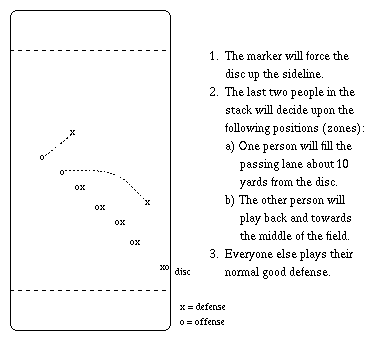
Zone Defense
Rabbit Zone

Standard Zone
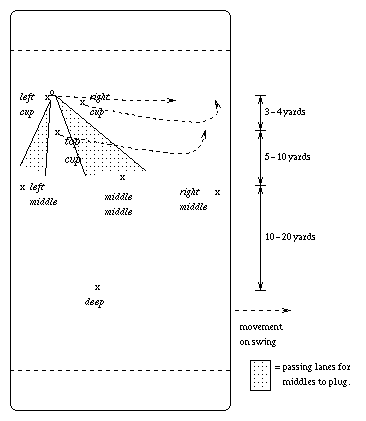
Salmon Zone
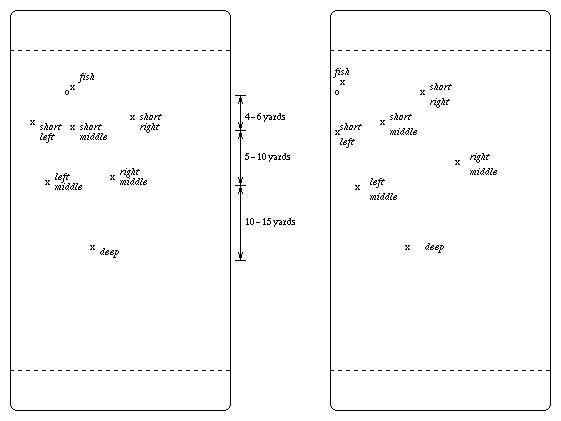
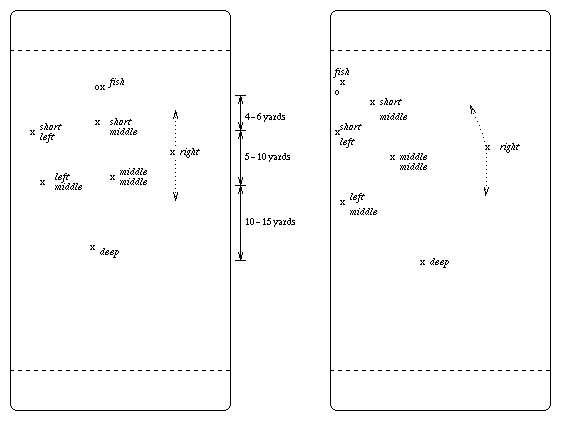
Endzone Set
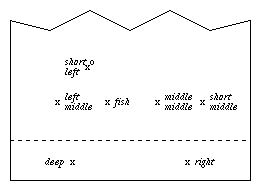
It's not really important where everyone lines up in the line of four.
The important thing is to have the right (or weak-side player) take one
back corner and the deep take the other. This is done because next to
the deep, the weak-side player should be able to cover the most ground
and read plays the best. The line of four listens to the people behind
them for directions. The player on the disc will mark the disc back
towards the middle of the field. When the disc gets moved, the marker
and the four defenders in a line will rotate much like the
wall zone. When leaving the wall to mark the disc, it is important
to approach the disc cautiously, trying not to allow the thrower to throw
to the space you just vacated, because the wall will need a few seconds
to adjust.
The Wall

4-person cup
4-person cup preventing the swing
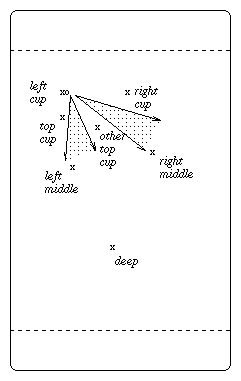
4-person cup preventing the dump
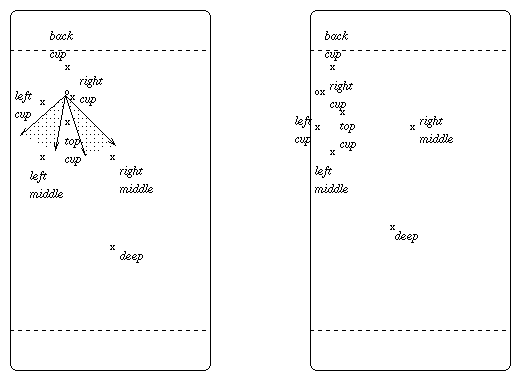
The Clam
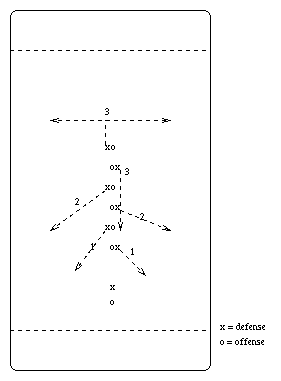
Offense

The stack is used to create space for people to run
and the disc to be thrown. There should be enough room between
players in the stack so that any one of them can run from the stack
without risking having their defender run into anyone (called a
pick). Take note of the areas that are shaded.
These are the areas that the receiver should expect the disc.

The thrower wants to make a throw that allows his/her teammate
to run in to the disc while making it hard for the defender to
touch the disc. This leads to putting a certain edge on
the disc depending on which way the thrower is being marked.
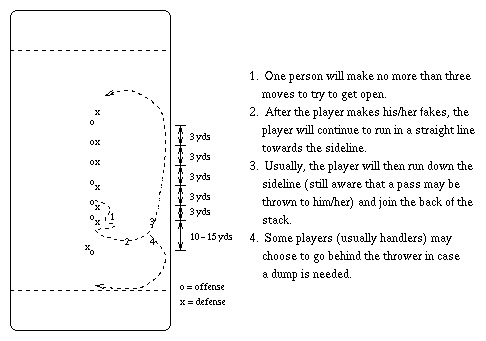
One person will leave the stack and try to get open. If
they don't get open they must clear the area to give room for
another person to cut.
The key is to keep lots of space clear for the disc to be thrown there
and for people to run there. The role of the thrower is to
Throwing a dump is usually easy because the defense is not concerned
if the offense moves the disc backwards. Dumps take place in the region
behind the thrower as diagrammed above. Once the thrower
decides to
throw a dump, he/she will pivot so that his/her endzone is now to
his/her back. He/she will take note of which side of the
receiver the defender is positioned and look to throw the disc to the
opposite side. He/she will then make eye contact with the receiver and
throw a short pass to the open side of the receiver allowing the
receiver to run to the disc. In most cases, dumps can be used to
break the defense's force or to initiate a give and go cut.


Three players may try to work the disc up the field by
themselves if the other players give them room. So as not to
tip the play too early, the four remaining players usually
stay stacked and within about 25 yards of the disc, moving
back as the disc is advanced.
Zone Offense
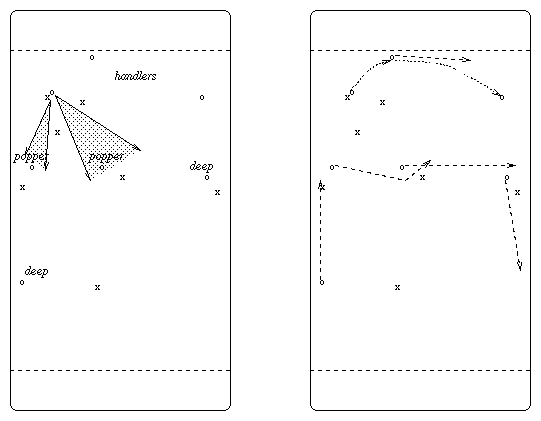
The set up of the standard zone offense is shown on the
left. One way for the offense to move is shown on the right.
This movement usually begins when the disc is dumped back.
If the swings don't happen quickly, the poppers should be
moving (usually one following the other through an area)
trying to get passes through the holes of the cup.
The Berkeley
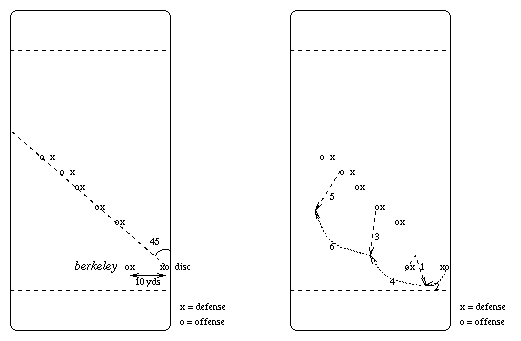
The berkeley is lined up even with the disc to allow the
thrower to throw the disc on either side of the mark. The
berkeley will primarily try to get open for a dump and swing
play, but if the sideline is open and so is the berkeley,
a pass up the line is also good.
Endzone Offense
